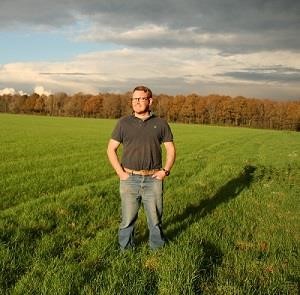Anthony Becvar from Little Goldsmiths Farm, Blackboys, Uckfield, East Sussex supports CFE by retaining his field margins
 Arable/grassland farm in the High Weald, on heavy clay – 100 acres of arable, 100 acres of grass.
Arable/grassland farm in the High Weald, on heavy clay – 100 acres of arable, 100 acres of grass.
My margins were under Countryside Stewardship (CSS) in 2002. In 2012, when the Stewardship agreement came to an end, I transferred the margins into Entry Level Stewardship (ELS). They originally varied in width from between 4m to 8m under the flexible rules of CSS, but now they are all 6m wide for ELS. In total there are 2.5ha of margins.
I have retained the margins as they have been there for 15 years now and on our heavy clay, the margins have contributed to the ease of management. It would involve a lot of work and time to remove them and to reinstate them. In fact, it would actually be counterproductive as we operate a min till system here and have spent a lot of time creating a productive and workable tilth. Ploughing field edges would require, undoubtedly, bringing some clay to the surface which would create poor field edges that we’d have to work with. We only have a short window to work on our heavy land and do our utmost to avoid compaction and rutting. [Working the clay at the wrong time just causes damage and brings problems and further costs later on].
One reason we’re keeping the margins is that fallow land is being counted towards the Ecological Focus Area rules under the new Common Agricultural Policy from 2015. I have removed them from ELS entirely, using low input hay meadows to recoup the lost points. This means we still get our full ELS payment rather than a reduced rate, but can still use the margins to help gain our EFA target. The EFA fallow rules for these margins are much more flexible (just cross compliance rules) than ELS allowing us to use them for access, which will help now that the hedge cutting ban has been lengthened to the end of August.
The margins definitely benefit the farm from a wildlife point of view. RSPB Volunteer & Farmer Alliance bird surveys have found skylarks everywhere, also yellowhammers, even turtle doves. The margins provide vital feeding grounds, shelter and nesting areas for many birds. We have kestrels, two barn owls, and brown hare. The margins shelter all kinds of wildlife from farming operations.
When choosing locations for the margins, it made sense to put them in the colder, shadier areas, along woodland edges for example, and at the edges of some wetter fields, where the fields drain. These areas are best taken out of production given the issues that we face, farming on the clay. In some of the better fields, only two sides have margins, or we have used 2m or 4m margins instead of 6m.
On a small farm, that is very marginal, we probably save money on inputs by having margins on the less productive areas. The margins protect the hedges from in-field farming operations including spraying. We still have to meet obligations under LERAPs and cross compliance strips, so margins help take the stress out of this.